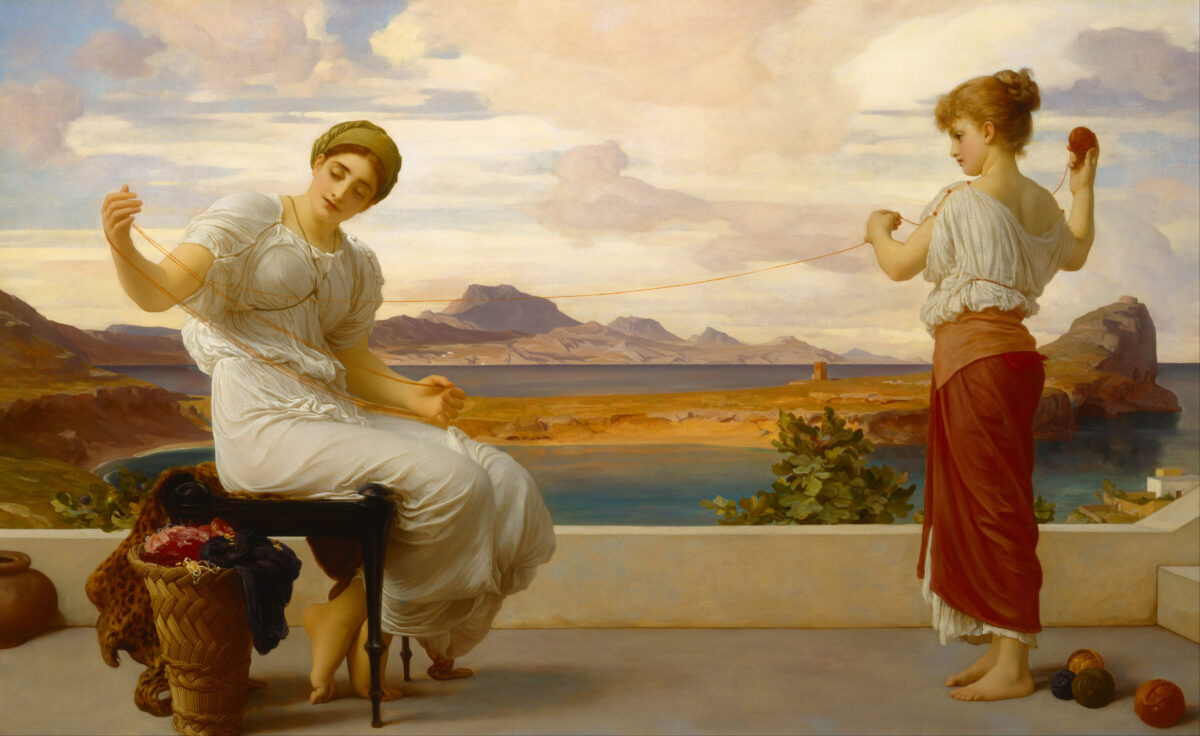
There’s always a place for the beauty, care, and respect found in traditional culture. We can search for it and find a way to bring it into the future so that the generations after us have a foundation on which they can build.
The 19th-century British painter Frederic Leighton inspired me to deeply think about tradition with his painting “Winding the Skein.”

‘Winding the Skein’
In Leighton’s “Winding the Skein,” we see two figures winding yarn into a ball. The figure on the left is older than the figure on the right and gives off a motherly impression. We will call the figure on the left the mother and the figure on the right her daughter.
The mother is dressed in simple, white, classical clothing, and she sits on a small bench. To her right is a basket of different colored yarns. She looks at the reddish yarn between her two hands, which she holds for her daughter.
Her daughter, dressed in a white top and a reddish skirt, pulls the yarn from her mother’s hands and winds it into the ball she holds. By her feet are other finished balls of yarn, which reveals that these two have been working for awhile.
The mother and daughter are working as a team on a balcony. There are steps that begin to the right of the daughter. The two work in front of a mountainous seascape, under a cloudy but bright sky.
So what exactly might this mean? What meaning may we interpret for our lives today?
Building on Tradition With Care and Respect
As an artist, one of the first things that stands out to me is the care with which the mother looks at the yarn she holds. The look on her face denotes a certain level of respect for her craft, which translates into expertise, for I presume this craft is something that she has taught or is teaching her daughter.
This makes me think that expertise cannot happen without deep care and respect for the craft, whatever that craft may be. We can take this attitude into our homes and our workplaces so that we too may approach life and work with the care and respect that it deserves.
With that said, this painting also makes me think that not only are traditional crafts passed on from generation to generation, but this type of attitude or way of thinking can also be transmitted, and the relationship between craft and mindset can constitute what we call culture. Thus, it is culture that can be passed from generation to generation.
Does the yarn potentially represent the transmission of traditional culture? The mother, representing tradition in her classical dress, passes the yarn to her daughter. The daughter winds the yarn into a ball, which will be used later to create textiles.
Textiles are a form of creation: They are used to create clothes, tablecloths, bedding, and so on. If the daughter represents the younger generation, is it the case that the source of the daughter’s creativity is the mother, that is, tradition?
Interestingly enough, the daughter’s skirt is the color of the yarn she winds, as if that yarn was used at some point to create the skirt she now wears. Does this suggest that the younger generations can adorn themselves and the culture they inherit with the beautiful crafts and attitudes found in tradition?
If so, how does this transfer of beauty, care, and respect occur? How does the younger generation bring forth the beauty, care, and respect of old?
The mother looks with care and respect at the yarn, which represents culture, but the daughter looks intently at her mother. The mother, no longer a child and now an expert in her craft, fulfills the role of caring for culture. In a way, caring for culture is caring for her daughter.
But the daughter, looking at her mother, must recognize her mother’s efforts. The daughter must be willing to learn from her mother, to take in the wisdom and experience garnered by her. The younger generations must be willing to learn from the successes and failures of the prior generations; the younger generation must be willing to learn from tradition.
The two generations must work together. They must work in harmony. The two figures are harmonized not only with each other but also with the mountainous seascape behind them. Even the yarn that hangs between them flows in tandem with the ledge of the balcony, the body of land behind them, and the horizon line.
The beauty, care, and respect brought forth by tradition harmonizes the generations with each other and with nature. Thus, the landscape might also represent the space upon which the younger generation will integrate its inherited culture.
This does not mean that the daughter will only do what the mother teaches; this does not mean that the younger generation will have its creativity stifled by the rules of tradition. If anything, the foundation of tradition allows for different forms of expression, hence the different color and design of the daughter’s skirt.
Tradition can be used to elevate the younger generation into something more beautiful, more caring, and more respectful than the previous generation. Is this why the steps are behind the daughter? It’s as if the daughter can take the information she’s learned from her mother, turn around at any moment, and walk up the steps behind her.
But walking up the steps behind her suggests that the daughter may have to turn away from her mother, that is, turn away from tradition.
This doesn’t mean that the daughter denies tradition as a whole, but maybe it suggests that it is also the younger generation’s responsibility to leave behind anything that is destructive. Just because something has been done for a long time doesn’t mean there isn’t a better way of doing it.
So, I can imagine the daughter learning all there is to learn about winding the skein until she masters it herself. She too comes to approach her craft with the care and respect it deserves, and through care and respect, she builds on the tradition passed to her, helping to create in its stead a culture even more beautiful.
She turns around and walks up those steps to another platform where she, as an adult in her white top and reddish skirt, sits on a bench to teach her children a tradition they can hopefully build on.
The traditional arts often contain spiritual representations and symbols the meanings of which can be lost to our modern minds. In our series “Reaching Within: What Traditional Art Offers the Heart,” we interpret visual arts in ways that may be morally insightful for us today. We do not assume to provide absolute answers to questions generations have wrestled with, but hope that our questions will inspire a reflective journey toward our becoming more authentic, compassionate, and courageous human beings.
Eric Bess is a practicing representational artist and is a doctoral candidate at the Institute for Doctoral Studies in the Visual Arts (IDSVA).





Be the first to comment